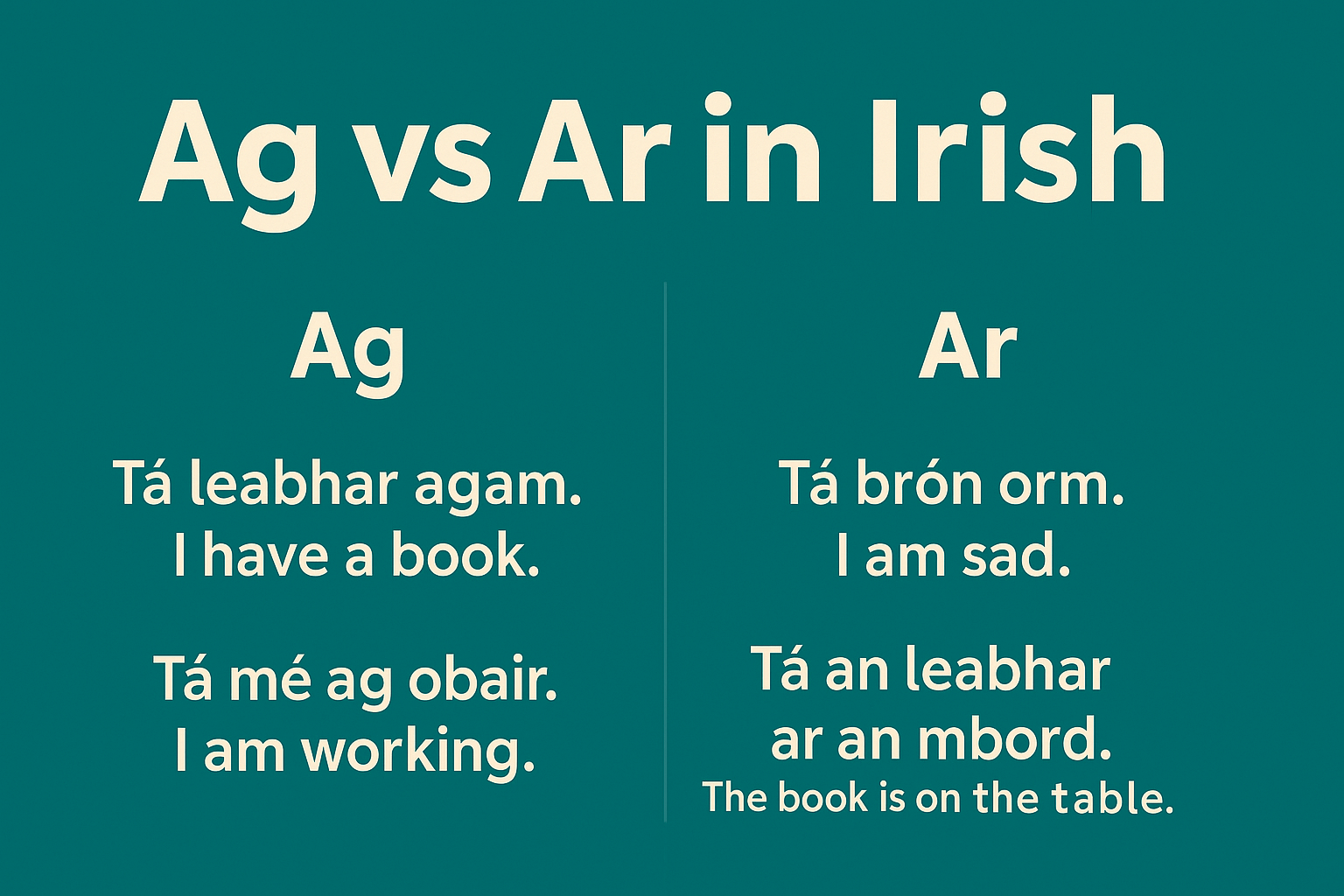Learning Irish is full of exciting discoveries, but some of the trickiest moments happen when words don’t translate directly into English. Prepositions are a great example of this—and none more so than ag and ar. Many learners struggle with when to use ag vs ar in Irish, since both can sometimes translate as “at” or “on” depending on the context. The truth is, these prepositions carry different shades of meaning, and mastering them is essential to sounding natural.
In this guide, we’ll explore the rules, give you practical examples, highlight common mistakes, and share tips on how to practice effectively with Gaeilgeoir AI’s learning tools.
Understanding Ag and Ar
Both ag and ar are prepositions, but they’re used in very different ways.
- Ag often indicates possession, continuous actions, or being “at” a place.
- Ar usually conveys location “on” something, emotional states, or obligations.
While both may seem to overlap with English “at” or “on,” they’re not interchangeable. Knowing when to use one or the other is about understanding Irish ways of expressing ideas.
When to Use Ag in Irish
You use ag in several key contexts:
1. Expressing Possession
Irish doesn’t use the verb “to have” the way English does. Instead, ag + pronoun shows possession.
- Tá leabhar agam. – I have a book.
- Tá carr acu. – They have a car.
2. Describing Actions in Progress
Ag marks the continuous present tense.
- Tá mé ag léamh. – I am reading.
- Tá sí ag canadh. – She is singing.
3. Being at a Place
When you’re “at” a location, ag is usually the correct choice.
- Tá mé ag an teach. – I am at the house.
- Tá siad ag an scoil. – They are at the school.
When to Use Ar in Irish
Ar carries a different set of meanings.
1. On Top Of / Upon
Literal sense of “on.”
- Tá an leabhar ar an mbord. – The book is on the table.
- Tá hata ar a cheann. – There is a hat on his head.
2. Feelings, Conditions, and Obligations
Many emotions or states are expressed with ar.
- Tá ocras orm. – I am hungry.
- Tá brón uirthi. – She is sad.
- Tá náire air. – He is embarrassed.
3. Dependence or Burden
Ar also conveys obligations or things pressing upon someone.
- Tá sé ar intinn agam. – It is on my mind.
- Tá sé orm é a dhéanamh. – I must do it.
Comparing Ag vs Ar: Key Differences
Here are a few contrasts to illustrate when to use ag vs ar in Irish:
- Possession vs. Condition
- Tá peann agam. – I have a pen.
- Tá brón orm. – I am sad.
- Location vs. Position
- Tá sé ag an doras. – He is at the door.
- Tá sé ar an doras. – He is on the door.
- Action vs. Obligation
- Tá mé ag obair. – I am working.
- Tá sé orm obair a dhéanamh. – I must do work.
Common Mistakes Learners Make
- Direct Translation from English
Learners often default to “at” = ag and “on” = ar, but Irish is more nuanced. - Mixing up emotions and possession
Remember: you “have” things with ag, but feelings are “on” you with ar. - Forgetting mutations
Both prepositions cause mutations in Irish. For example:- Tá sé ag an gcathair. (urú)
- Tá an hata ar a cheann. (séimhiú)
Practical Examples in Sentences
Here are more examples to guide you:
- Tá bia agam. – I have food.
- Tá fuacht orm. – I am cold.
- Tá sí ag an siopa. – She is at the shop.
- Tá leabhar ar an mbord. – There is a book on the table.
- Tá áthas orainn. – We are happy.
- Tá mé ag obair ar thionscadal. – I am working on a project.
Notice how the choice between ag and ar shifts the meaning.
How to Practice Ag vs Ar
- Make flashcards: Write a sentence with ag on one side and an equivalent with ar on the other.
- Practice daily conversation: Try describing what you “have” (with ag) and how you “feel” (with ar).
- Use Gaeilgeoir AI’s interactive tools: Our AI-powered platform gives you immediate corrections, helping you avoid fossilizing mistakes.
For a deeper dive into how Irish prepositions work, check out our guide on understanding Irish prepositions.
Quick Exercise
Translate the following into Irish using ag or ar:
- I have a dog.
- She is tired.
- The keys are on the table.
- We are at the school.
Answers:
- Tá madra agam.
- Tá tuirse uirthi.
- Tá na heochracha ar an mbord.
- Táimid ag an scoil.
Final Thoughts
Learning when to use ag vs ar in Irish is about more than memorizing translations—it’s about seeing how Irish speakers frame the world. With ag, you describe what you own, what you’re doing, or where you are. With ar, you capture what’s “on” you, whether it’s a hat, a feeling, or a responsibility.
It takes practice, but with clear examples and regular usage, these prepositions become second nature.
At Gaeilgeoir AI, our goal is to make grammar intuitive and enjoyable. By practicing with our AI-driven tools, you can build sentences, get instant feedback, and grow confident in real-world Irish.
👉 Ready to master prepositions and beyond? Join for free and connect with a community of learners bringing Irish to life every day.


